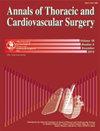泛驱动阴性与表皮生长因子受体突变对c期IA型肺腺癌磨玻璃样混浊的影响
IF 1.3
4区 医学
Q4 CARDIAC & CARDIOVASCULAR SYSTEMS
引用次数: 2
摘要
目的:我们旨在验证具有磨玻璃样混浊(GGO)成分的临床(c)期IA肺腺癌的表皮生长因子受体(EGFR)突变的预后。方法:我们对226例经手术切除的带有GGO成分的c期IA肺腺癌进行了评估。终点为总生存期(OS)和无复发生存期(RFS)。Kaplan–Meier分析和对数秩检验用于估计生存差异。使用单变量和多变量Cox比例风险模型评估预后因素。结果:226例中,177例携带EGFR突变型腺癌,其中GGO组分。平均随访时间为54.4±1.2个月。EGFR突变组和野生型组之间的5年OS和RFS没有显著差异(5年OS 100%对94.3%,风险比[HR]0.276,P=0.168;5年RFS 94.7%对95.7%,HR0.873,P=0.864)。多变量Cox风险模型显示,放射学固体成分大小(P=0.010)和病理结阳性(P=0.036)是较差RFS的重要预测因素。结论:EGFR突变不是具有GGO成分的c期IA肺腺癌OS和RFS的预后因素。放射学实体成分大小和病理性淋巴结状况是RFS恶化的独立预后因素。本文章由计算机程序翻译,如有差异,请以英文原文为准。
Pan-Driver-Negatives versus Epidermal Growth Factor Receptor Mutants for C-Stage IA Lung Adenocarcinoma with Ground-Glass Opacity
Purpose: We aimed to verify the prognosis of epidermal growth factor receptor (EGFR) mutation of clinical (c)-stage IA lung adenocarcinoma with the ground-glass opacity (GGO) component. Methods: We evaluated 226 cases of surgically resected c-stage IA lung adenocarcinoma with GGO component. Endpoints were overall survival (OS) and recurrence-free survival (RFS). Kaplan–Meier analysis and the log-rank test were used to estimate the survival differences. Prognostic factors were assessed using the univariable and multivariable Cox proportional hazards model. Results: Among the 226 cases, 177 cases harbored the EGFR-mutant adenocarcinoma with the GGO component. The mean duration of follow-up time was 54.4 ± 1.2 months. The 5-year OS and RFS did not differ significantly between the EGFR-mutant and wild-type groups (5-year OS 100% vs. 94.3%, hazard ratio [HR] 0.276, P = 0.168; 5-year RFS 94.7% vs. 95.7%, HR 0.873, P = 0.864). Multivariable Cox hazard model revealed that radiologically solid component size (P = 0.010) and pathological node-positive (P = 0.036) were significant predictors of an inferior RFS. Conclusion: EGFR-mutant was not a prognostic factor of OS and RFS for c-stage IA lung adenocarcinoma with the GGO component. Radiologically solid component size and pathological lymph node status were independent prognostic factors of worse RFS.
求助全文
通过发布文献求助,成功后即可免费获取论文全文。
去求助
来源期刊

Annals of Thoracic and Cardiovascular Surgery
CARDIAC & CARDIOVASCULAR SYSTEMS-SURGERY
CiteScore
2.80
自引率
0.00%
发文量
56
审稿时长
4-8 weeks
期刊介绍:
Information not localized
 求助内容:
求助内容: 应助结果提醒方式:
应助结果提醒方式:


